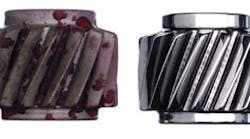Increasing demands for higher-quality products, together with pressure for cost reduct ions, are demanding that suppliers of engine and transmission components develop and adopt new value-adding process — like the patented REM Isotropic Superfinish (ISF) technology developed by REM Chemicals Inc. (www.remchem.com) and Rsler Oberflaechentechnik GmbH (www.rosler.com).
Milling, belt and wheel grinding, lapping, and honing of parts, frequently create a surface with many “peaks.” These peaks can interrupt the oil film — usually 0.2-0.5 μm thick — that is required for a reliable lubrication of high-performance parts. This can create gray staining and micro pitting on critical parts surfaces like, for example, the teeth of a gear.
The ISF technology removes the “peaks” on parts made from carbon steel, high-alloy steel, stainless steel, and titanium. The process smoothes the parts surfaces down to Ra of 0.02 μm and Rz of 0.2 μm, resulting in significant reductions in friction, wear, and operating temperatures.
The process is performed in vibratory mass-finishing systems specially designed by Rsler with dedicated high-density, non-abrasive ceramic media and active-chemical compounds. These REM chemical compounds create a thin oxide film (pH values of 1.6 - 5.5) on the part surfaces.
Due to the vibratory action in the work bowl, the ceramic media “wipes” off this oxide film. Over time this action removes the “peaks.” The lower lying “valleys” remain intact and serve as a reservoir for the lubricant. The process continues — with the constant addition of fresh compound — until the required surface finish is achieved.
Metal removal takes place very gently, preventing any nicking of the parts. While the ISF process may produce a slight edge break, it does not induce excessive radiusing (producing round edges) of the parts, because the media is non-abrasive.
The ISF process takes place at room temperature and does not affect the material properties of the metal component. It is followed by a rinsing/burnishing process in the same machine, using a burnishing compound mixed with water. The rinse/burnish process removes the remaining oxide film from the parts and creates a mat or high gloss finish.
Performance and efficiency of the components are significantly improved, which allows users to make gear parts smaller or use higher input power motors — at a significantly improved fatigue life. For example the life of gears processed with the ISF technology could be increased four- to fivefold. Moreover, the ISF system creates an isotropic structure on the parts’ surfaces, which substantially improves lubrication, reduces friction and wear, reduces operating noise, and reduces operating temperatures. This allows the operator to extend the time interval between preventive maintenance work. All these quality improvements also lead to energy savings.
Rsler offers a wide range of equipment, including double-curved-wall rotary vibrators. Such rotary vibrators induce an even parts/media rotation in the work bowl, allowing a 50% higher fill rate of parts and media compared to straight-wall vibrators. At the same time, double curved wall vibrators produce a much better surface finish.
The ISF technology produces a relatively small amount of effluent, which can be treated with conventional wastewater treatment systems. Due to its low wear rate the high-density ceramic media used for the ISF process can be used for a long time, before it must be replaced.










